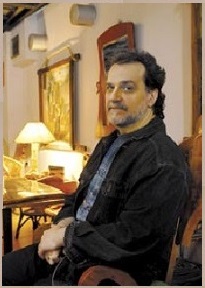In his monumental scientific research, which according to its methodology is multidisciplinary and is based on a complex system of deductive research in the field of paleolinguistics, anthropology, archeology, mythology, ethnology and other scientific disciplines, the intuitive and erudite genius of Branko Sotirovski leads us on a fascinatingly cognitive journey into the distant past, which modern science still regards as an alternative, hypothetical, sometimes even phantasmagorical journey,


, in which even the dedicated scientists in this area, certainly those academically oriented scholars whose main task is to defend the petrified conservative scientific view as a kind of scientific guard, in many ways eligible to dogmatics from the period of the Inquisition, get a blurred mind and experience darkening of their rudimentary scientific worldview. But for every devotee with open cognitive awareness and lively intellectual intuition, this scientific research of the great enthusiast, author of this book entitled “Zeta Macedonia”, Branko Sotirovski, is a real elixir of knowledge and the investigative journey onto to which he leads us as a true adept and alchemist, is an incomparably exciting adventure of the spirit. One needs to have a great intellectual courage, but even more talent and knowledge as a scholar to engage into so delicate and bold exposure, in which on the surface of the conscious truths show up, shocking and amazing, but at the same time thesis appears, which this extraordinary researcher of the most delicate areas of deep history (in fact, according to academic terminology – prehistory) claims with astonishing precision and with real scientific arguments, based on artеfacts, but also on principal logical methods from referential scientific disciplines.
Ever since historical science was established in the new century, i.e. after the escalation of the renaissance spirit of cognition, there is constant periodic correction of the established parameters on the origin, but also on the historical time in which mankind with an evolutionary process of Gnostic initiation has transited from an age of irrationality to conscious existence on this planet, or if you prefer, from an animal and spontaneous existence, largely based on instincts, towards aspiration for spirituality and creativity, civilizational indicators, which are grounded on speech, writing, the arts, technology and social organization. The biggest scientific controversies in historic time have existed and still exist about the date and the context of these, in any case, fascinating phenomena, not only globally, but also on a universal level.
Without a doubt, the main resources of this scientific systematization lie heavily on the diversity of mythology that mankind has created as an urge to reflect and express itself in the infinity of space-time, as a phenomenon uncomparable with any other phenomenon in the universe. The historical and empirical sublimation of these mythologies created religions that for a long period in human cognitive and social evolution had the role of interpreters of all unknown areas, which the living human spirit, always interested in the unknown, came across.
For example, according to the book of Genesis in the Old Testament, the estimate on the age of the world was 6 to 7 millennia, and this dogma held on fairly long, until the time of rationalism, when religious dogmatism, primarily the one which monopolized scientific topics, was thoroughly deconstructed by experimental argumentation and logic itself, which actually was the structural methodology of the scientific cognitive process. On the contracy, this transition of the scientific worldview did not take place smoothly and without reaction from conservative dogmatists. There are many martyrs in the name of scientific truth. Let us remember Giordano Bruno, who was burned at the stake by the Inquisition, the trial and mistreatment of Galileo Galilei by these same structures, hostile oriented towards scientific truths, which this lover of perfection of space structurology stood for in his writings, and which were not at the will of the Vatican. Let us recall the denial of the discoveries by Rev. Johannes Kepler, Isaac Newton, Tycho Brahe and other great scientists who the conservatives of the time of darkened minds saw as servants of witches and the devil. But truth, regardless of whether it is scientific or poetic, always requires sacrifice.
When the war against the Inquisition was finally won, and the church dogma was expelled from the scientific pantheon, sometime in the early XIX century, after nearly three centuries of martyrdom of progressive and creative forces in science and art, new challenges and controversies began to take place, but this time at least the scientific forum and the exchange of ideas functioned in a more tolerant manner, not necessarily meaning that the old manners were completely eradicated. Although the worldviews were greatly expanded and scientific argumentation became an inevitable method of proving various hypotheses, primarily for historical science, natural sciences and the science of the origin, which drew its arguments from the newly established scientific disciplines, based on the exact sciences (to mention the Kant-Laplace hypothesis about the origin of the universe), there was a new conflicting problem in the context of creating a consistent scientific worldview. This actually was the syndrome of the “Tower of Babel” and the mixing of languages or still better – of contexts. This enabled for the scientific truths in this new time to be determined by a kind of consensus on prominent academic experts, which somehow re-introduced world science in a kind of gnoseological dictatorship. Yet this academic authoritarian arbitration could not come even close to the rigidity and the violence of that of the inquisition.
But this idealistic period in science did not last long. Soon after the emergence of totalitarian ideologies such as Communism and Nazism, science was politicized, became ideologised and began to act as doctrinal apologies of these totalitarian systems. There are still living witnesses, primarily scientists, who have tasted the bitter punishment of these regimes for their non-dogmatic interpretation of certain scientific problems. I would even dare to say that this rigid totalitarian mentality in science is still present in certain academic circles as a relic.
Therefore this boldly scientific presentation of Branko Sotirovski can be targeted by these scientific dogmatists, relics of the Communist totalitarian mentality, who unfortunately are still well positioned in their academic bunkers, always ready for the fiercest attack.
This work of Branko Sotirovski is really provocative, perhaps one of the most daring analyses and decoding of the enigmas of the past. The mere mention of the figure of 400,000 years of civilization and literacy greatly irritates the perpetual commissioners of “common sense” in academic spheres. However, if to this we add that the prominent people of this civilization and written fertilization of humanity are Macedonians, namely, Gods Macedonians, these modern inquisitors of scientific awareness fall into delirium and maniacal fits, in their ideological and scientific fanaticism giving no chance for any different scientific truth, except for the one which they themselves represent, regardless of the argumentation based on facts and logic, implemented in this process of expertise. Let us remember that they still vehemently and fanatically advocate the thesis on the settling of the Slavs from behind the Carpathians, a thesis, so refuted by scientific arguments, and so much in the service of the geo-strategy and geopolitics of the XIX century, in order to give effect and legitimacy to a totally untrue, fabricated and quasi-scientific concept of Hellenism and to deprive the Slavs of their symbolic power and historical-civilizational dignity as the most serious cultural and political threat to the West. Despite all relevant historians and their works, despite the archaeological and linguistic evidence and references, this stupid and unproven theory by the geo-politician and rather than historian, linguist, archaeologist and anthropologist Droysen, has taken root in the academic scientific community, not only with the interested Western geostrategic imperialism, but here, in the East, among the Slavs, harassed for more than half a century by Communist ideology and Communist politicized science.
Therefore, this review is defensive and, above all, wants to warn, but also to free the hypothetical reader of all the pitfalls that lurk on this magnificent and colossal journey onto which we are invited and led by the fascinating scientific discovery of Branko Sotirovski. I deliberately did not want to get into a detailed analysis as to the rich and divergent scientific material which in this study is presented and and elaborated by the enthusiastic and courageous explorer of these amazing discoveries and phenomena. I just wanted to provide a framework for an entry, free from prejudice and petrified illusions, into this incomparable scientific research by Branko Sotirovski.